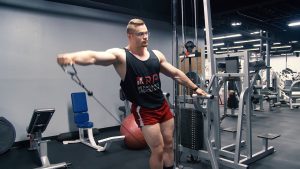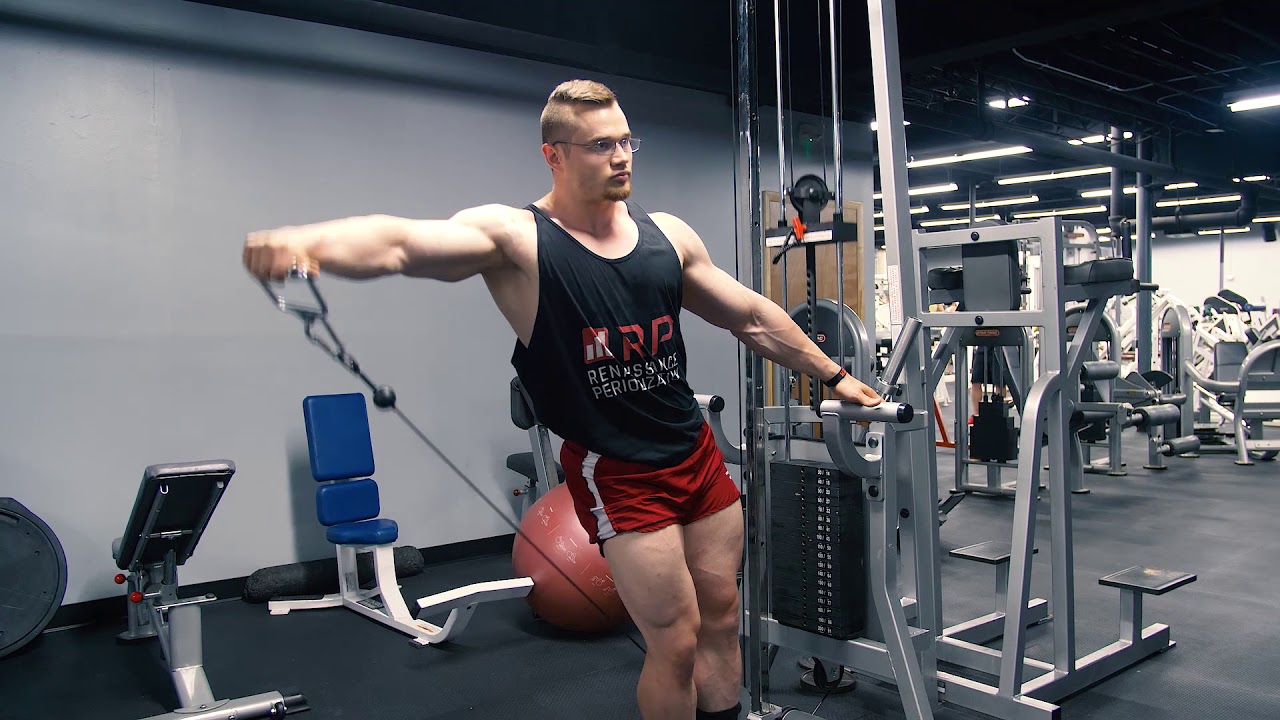Cable lateral raise is an exercise that targets the medial deltoid muscle, also known as the middle shoulder muscle.
It works in conjunction with the anterior deltoid, which is the front shoulder muscle, to provide support to the shoulder and protect against injury during common movements such as throwing or lifting.
While this exercise can help you improve your physique and strength, it also provides many additional benefits such as improving posture and reducing stress on your joints and ligaments.
How to Do A Cable Lateral Raise
There are many reasons why you would want to start doing lateral raises, but one of the most common is for shoulder strength and stability. This exercise strengthens your medial deltoid, which is a small muscle that helps keep your shoulders strong in activities like swimming and throwing.
The cable version of lateral raises allows you to target a wider range of motion than regular dumbbells, making it a better option for building strength in areas of your shoulders that may be under-developed or tight from overuse in other activities.
If you’re trying to increase upper body strength, adding cables into your routine may be just what you need. Here’s how to do it: Stand upright holding either side of an adjustable cable handle at arm’s length by your sides.

Slowly raise your arms out to your sides until they’re parallel with the floor, keeping them straight and elbows slightly bent. At that point, slowly lower your arms back down again.
If you want to make lateral raises more challenging, try moving your arms back a bit, so that they’re behind your body. This places more tension on your shoulder muscles and can increase resistance as well.
How It Works
The lateral raise is a good exercise to help build up your deltoids. Your deltoids (or shoulders) are muscles that help move your arms and shoulders in a circular motion. Because they work hard all day, they need more than just one type of exercise.
To avoid getting rounded shoulders (and to prevent yourself from slouching), it’s important to strengthen them with weight training exercises like the cable lateral raise! Here’s how you do it: Stand with your feet hip-width apart, grab an attachment from a low pulley cable machine, then lift both arms straight out to each side until they are parallel with your body. Lower them back down under control.
To make sure you get the maximum benefit from your exercise, be sure to keep your arms in a straight line as you lift them. Also, keep them away from your body as much as possible so that you’re working your deltoids instead of other muscles.
You can add weight by using an ankle or wrist weight or holding dumbbells in each hand. You’ll want to do three sets of 12 repetitions when doing lateral raises to really see results.
Start by lifting 10 pounds for two sets, then increase by 5 pounds every few weeks until you’re lifting 15 pounds for two sets. Your last set should be a challenging set where you feel like you could drop at any second—so pick up those weights and start shaping up.
Why Do A Cable Lateral Raise?
It’s a fact that there are many benefits of doing cable lateral raises. Not only do they allow you to choose from a wide range of different weight plates, but they also allow you to raise and lower your arms at your own pace without having to go back and forth from a weight rack as you have to do with dumbbells.
Doing lateral raises with cables lets you isolate your shoulder muscles effectively. Because it’s just one set, you can always add as much weight as possible for more intensity or lift lighter weights if you need an easier workout that day.
A lot of men and women prefer cable lateral raises because it targets their shoulder muscles in ways they cannot achieve while doing another exercise with weights, such as an overhead press or bicep curl.
When you’re doing a cable lateral raise, you can also adjust your grip to focus on specific areas of your shoulder muscles.
This is helpful when you want to work on strengthening one side more than another because it means that you’ll be able to better isolate each muscle group.
When done correctly, a cable lateral raise will also activate your core muscles and help improve your balance. This is because it’s not just your arms that are moving but your whole body as well.
Are cable lateral raises better?
Cable lateral raises are often preferred over dumbbell lateral raises because they allow you to stabilize your core throughout each rep. Your shoulders and obliques (side abs) do most of the work in a cable lateral raise, so if you don’t have much help from your core, consider using dumbbells instead.
Cable or dumbbell—do I need both?: You don’t necessarily need both options; but, it depends on what your goal is and how long-term that goal is.
For example, if lifting weights is something you want to do for life (aka 10+ years), then keep your body guessing by changing up exercises every 6-8 weeks or so. You could also choose a split routine: 4-5 days on one lift, 2 days off; repeat.
You may not need both depending on your goals. I recommend dumbbells for beginner and intermediate-level lifters who aren’t necessarily looking to add a lot of muscle but want more resistance than a machine can offer.
If you’re looking to build muscle, then go with cables—they’re easier on your joints (less weight and greater range of motion), so they can be a good choice for the beginner or advanced lifters.
What Muscles do Cable Lateral Raises Work?
Cable lateral raises are commonly used by bodybuilders to target their middle deltoids. Cable lateral raises are actually a little different than other shoulder exercises, such as dumbbell side laterals and seated lateral raises.
For one thing, your grip is wider with cable lateral raises because your hands aren’t placed together on a single handle as they would be with dumbbells or cables.
As a result, you’re more likely to recruit higher-order stabilizer muscles in your rotator cuff, which will help keep your shoulders healthy over time.
If you’re working toward building bigger shoulders, cable lateral raises may be a good option for an isolation exercise. But because they aren’t very taxing, it’s usually best to pair them with other exercises that work your shoulders more effectively and efficiently.
Cable lateral raises are among one of three basic exercises used by bodybuilders and weightlifters as part of their shoulder workouts. They can also help tennis players improve their swings and golfers improve their putting, since building stronger rotator cuffs can help prevent injuries and maintain proper form while playing sports.
What is the heaviest lateral raise?
It may be tempting to grab that big 20-pound dumbbell and get lifting. However, don’t let your ego steer you in that direction. Those bigger weights are harder on your joints, and if your goal is muscle growth, staying away from them is best.
The more moderate weight—in a resistance range of 15-20 pounds—won’t bulk up those muscles as quickly, but it will build more functional strength.
If at all possible, try to go even lighter with a 10- or 12-pound dumbbell. You’ll work plenty hard and still get amazing results! Also, keep in mind that what matters most isn’t how much weight you lift but how many reps and sets you can do with good form.
Is lateral raise push or pull?
A lateral raise is a shoulder isolation exercise that targets your side deltoid head. The problem is, that it’s classified as both a push and pull exercise in different variations of fitness training.
Let’s take a look at how a cable lateral raise works and what muscles are being targeted to decide which classification it falls under.
As you’ll see, there are three main ways to do cable lateral raises with each targeting slightly different muscle groups while using slightly different motions.
This means that depending on which variation of lateral raise you do, it could be categorized as a push or pull exercise.
How to perform cable lateral raises:
- Select a weight that you can lift with only one shoulder.
- Stand next to the pulley machine with your feet shoulder-width apart.
- To maintain good posture, push your chest forward, and point your shoulders back while slightly bending both knees. You can also place your free hand on the machine for support.
- Now, reach across your body and grab the stirrup with your outside arm.
- Slightly bend your elbow to a 10- to a 30-degree angle and raise your arm sideways until it’s level with your shoulder, exhaling as you lift.
- Avoid rotating your arm as you raise the stirrup, and keep your focus on the area you want to train — your middle shoulder.
- Hold your position for 1–5 seconds, and then inhale while slowly lowering the weight back. Let the cable come to a complete stop before beginning the next repetition.
- Do at least 10–15 reps per set for each arm.
